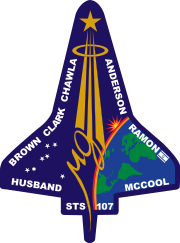STS-107
This article needs additional citations for verification. (March 2010) |
| COSPAR ID | 2003-003A |
|---|---|
| SATCAT no. | 27647 |
| Crew | |
| Members | 7 |
| End of mission | |

 | |
STS-107 was a space shuttle mission by NASA using the Space Shuttle Columbia, launched 16 January 2003. This was a multi-disciplinary microgravity and Earth science research mission with a multitude of international scientific investigations conducted continuously during 16 days in orbit.[1]
The seven-member crew died on 1 February 2003 when the shuttle disintegrated during reentry into the Earth's atmosphere. The cause of the accident was determined to be a piece of foam that broke off during launch and damaged the thermal protection system components (reinforced carbon-carbon panels and thermal protection tiles) on the leading edge of the left wing of the Shuttle orbiter, causing an extensive heat build-up. During re-entry the damaged wing slowly overheated and came apart, eventually leading to loss of control and total disintegration of the vehicle.
Mission highlights
This section needs expansion. You can help by adding to it. (March 2010) |
STS-107 carried the SPACEHAB Double Research Module on its inaugural flight, the Freestar experiment (mounted on a Hitchhiker Program rack), and the Extended Duration Orbiter pallet. SPACEHAB was first flown on STS 57.
One of the experiments, a video taken to study atmospheric dust, may have detected a new atmospheric phenomenon, dubbed a "TIGER" (Transient Ionospheric Glow Emission in Red).[2]
On board the Columbia was a copy of a drawing by Petr Ginz, the editor-in-chief of the magazine Vedem, who depicted what he imagined the Earth looked like from the Moon when he was a 14-year-old prisoner in the Terezín concentration camp. The copy was in the possession of Ilan Ramon and was lost in the crash. Ilan Ramon also travelled with a dollar bill received from the Lubavitcher Rebbe.[3]
Crew
| Position | Astronaut | |
|---|---|---|
| Commander | Rick D. Husband Second spaceflight | |
| Pilot | William C. McCool First spaceflight | |
| Mission Specialist 1 | David M. Brown First spaceflight | |
| Mission Specialist 2 | Kalpana Chawla Second spaceflight Flight Engineer | |
| Payload Commander | Michael P. Anderson Second spaceflight | |
| Mission Specialist 4 | Laurel B. Clark First spaceflight | |
| Payload Specialist 1 | Ilan Ramon First spaceflight | |
Mission parameters
- Mass:
- Orbiter Liftoff: 119,615 kilograms (263,706 lb)
- Orbiter Landing: 105,593 kilograms (232,793 lb)
- Payload: 14,553 kilograms (32,084 lb)
- Perigee: 270 kilometres (170 mi)
- Apogee: 285 kilometres (177 mi)
- Inclination: 39.0°
- Period: 90.1 min
Insignia


The central element of the patch is the microgravity symbol, µg, flowing into the rays of the astronaut symbol.
The mission inclination is portrayed by the 39 degree angle of the astronaut symbol to the Earth's horizon. The sunrise is representative of the numerous experiments that are the dawn of a new era for continued microgravity research on the International Space Station and beyond. The breadth of science and the exploration of space is illustrated by the Earth and stars. The constellation Columba (the dove) was chosen to symbolize peace on Earth and the Space Shuttle Columbia. The seven stars also represent the mission crew members and honor the original astronauts who paved the way to make research in space possible. Six stars have five points, the seventh has six points like a Star of David, symbolizing the Israeli Space Agency's contributions to the mission.
An Israeli flag is adjacent to the name of Payload Specialist Ramon, who was the first Israeli in space. The crew insignia or 'patch' design was initiated by crew members Dr. Laurel Clark and Dr. Kalpana Chawla.[4] First-time crew member Clark provided most of the design concepts as Chawla led the design of her maiden voyage STS-87 insignia. Clark also pointed out that the dove in the Columbia constellation was mythologically connected to the explorers 'The Argonauts' who released the dove.[5]
See also
References
- ^ http://spaceflight.nasa.gov/shuttle/archives/sts-107/science/index.html
- ^ "Columbia crew saw new atmospheric phenomenon". Newscientist.com. Retrieved 10 December 2010.
- ^ "Israeli astronaut busy up in space". Jewish Telegraphic Agency. Retrieved 22 May 2011.
- ^ "Www.spacepatches.nl – Space Shuttle – STS-107". Spacepatches.nl. 16 January 2003. Retrieved 10 December 2010.
- ^ Constellation Columba
External links
- NASA's Space Shuttle Columbia & Her Crew
- NASA STS-107 Crew Memorial web page
- NASA's STS-107 Space Research Web Site
- Spaceflight Now: STS-107 Mission Report
- Science Reports
- Press Kit
- Article describing experiments which survived the disaster
- Article: Astronaut Laurel Clark from Racine, WI
- Status reports Detailed NASA status reports for each day of the mission.
- Raw Video Reconstruction of Re-entry, Tribute Videos, and More



